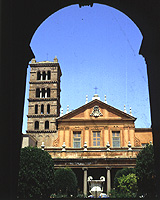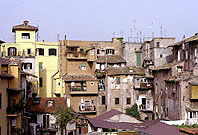Trastevere
St. Cecilia in Trastevere
 A tranquil spot with ancient fountain and lilies in the garden, and a superb fresco of multicolored winged angels in the Convent.
A tranquil spot with ancient fountain and lilies in the garden, and a superb fresco of multicolored winged angels in the Convent.
St. Cecilia, a noblewoman, died a horrible death on this spot in her own home. First they tried to suffocate her in her private steam baths: she emerged refreshed. Then, an executioner tried to chop of her head; he botched the job so badly she lingered on for three days, converting many to Christianity before she died.
The experts differ on this date: some say it happened during Marcus Aurelius' reign (161-180 AD), others Alexander Severus (222-236 AD), and still others Diocletian (284-303 AD).
Take your pick. A shrine was built to her in this house in the 5C (though her body and that of her husband St. Valerian who also died a martyr's death had been buried at the St. Callisto Catacombs, outside the Walls. The Roman rule was no dead bodies within the precincts of the city, for health reasons).
Pope Paschal I searched all over the place for her tomb, and in 820 AD found it in the Catacombs, then disinterred her body and that of her husband and brought them back to their house, making a church over the burial crypt. They are buried in the same steam baths where she survived the first attempt on her life (see the heating tubes on the wall).
The baroque facade was remodeled centuries later, but the 12 C porch and mosaics were kept. The bell tower, leaning slightly, is from the same epoch.
Inside are some 9C mosaics depicting St. Paschal with a square halo, showing he was still alive; a baldachin over the altar (di Cambio 1293); the tomb of English Cardinal Adam Easton (d. 1393); and in the crypt don't miss the statue (Maderna 1599) sculpted from her corpse. (They opened the tomb to see if it really was Cecilia.)
Rediscovered in 1900 and not to be missed is the stupendous fresco remnants of the Last Judgement (Pietro Cavallini 1293 - who did the mosaics in Santa Maria in Trastevere). The angels' wings, graduated multicolored feathers in pinks and reds, and the figures in their pleated robes are gorgeous.
Diagonally opposite the church on the right of the square is another lovely medieval house with columns and an arched extension with travertine feet running along the whole facade.
![]() Continue up the Via di Santa Cecilia and turn left of Via dei Genovesi, and immediately right on Vicolo dell'Atleta
Continue up the Via di Santa Cecilia and turn left of Via dei Genovesi, and immediately right on Vicolo dell'Atleta
No. 14, Vicolo dell'Atleta is a jewel of Dark Ages architecture as are the houses next to it. Because of some Jewish script on the central column, this had been identified as an ancient Synagogue, founded by the famous lexicographer Nathan ben Jechiel (1035-1106).
Two fabulous antique sculptures were found under Nos. 13-15 100 years ago, including Apoxyomenos, now in the Vatican Museum (a fine marble rendition of an "Athlete" holding a "strigil", an implement to take off excess oil from the body after exercise or a combat, a Roman copy of the Greek master sculptor Lysippus).
Also under the same house, a gorgeous bronze statue of a horse, this time the Greek original (probably dating from IV Century BC).
This former synagogue now operates as a to-hire restaurant for groups who are served specially prepared meals in this hallowed precinct.
 From Vicolo dell’Atleta turn left on Via dei Salumi, and continue to Via Arco di Tolomei - another ancient arch, though widened 100 years ago. Go through the arch and up the hill; on your left at No. 1 is a Medieval Tower of great height incorporated in the present building.
From Vicolo dell’Atleta turn left on Via dei Salumi, and continue to Via Arco di Tolomei - another ancient arch, though widened 100 years ago. Go through the arch and up the hill; on your left at No. 1 is a Medieval Tower of great height incorporated in the present building.
All the houses on the left are easy on the eye, and venerable.
In the center of Piazza in Piscinula, at No. 1 is the block of exquisite antiquity which is heavily restructured - but with medieval casements, windows, doors bricks, columns. A delight, and instructive in learning how people lived back then (see the heavy wrought iron on the windows).
Our walk has now ended, though in this same neighborhood there are lots more old treats to discover for yourself.